Intel Core i7 3960X (Sandy Bridge E) Review: Keeping the High End Alive
by Anand Lal Shimpi on November 14, 2011 3:01 AM EST- Posted in
- CPUs
- Intel
- Core i7
- Sandy Bridge
- Sandy Bridge E
No Integrated Graphics, No Quick Sync
All of this growth in die area comes at the expense of one of Sandy Bridge's greatest assets: its integrated graphics core. SNB-E features no on-die GPU, and as a result it does not feature Quick Sync either. Remember that Quick Sync leverages the GPU's shader array to accelerate some of the transcode pipe, without its presence on SNB-E there's no Quick Sync.
Given the target market for SNB-E's die donor (Xeon servers), further increasing the die area by including an on-die GPU doesn't seem to make sense. Unfortunately desktop users suffer as you lose a very efficient way to transcode videos. Intel argues that you do have more cores to chew through frames with, but the fact remains that Quick Sync frees up your cores to do other things while SNB-E requires that they're all tied up in (quickly) transcoding video. If you don't run any Quick Sync enabled transcoding applications, you won't miss the feature on SNB-E. If you do however, this will be a tradeoff you'll have to come to terms with.
Tons of PCIe and Memory Bandwidth
Occupying the die area where the GPU would normally be is SNB-E's new memory controller. While its predecessor featured a fairly standard dual-channel DDR3 memory controller, SNB-E features four 64-bit DDR3 memory channels. With a single DDR3 DIMM per channel Intel officially supports speeds of up to DDR3-1600, with two DIMMs per channel the max official speed drops to 1333MHz.
With a quad-channel memory controller you'll have to install DIMMs four at a time to take full advantage of the bandwidth. In response, memory vendors are selling 4 and 8 DIMM kits specifically for SNB-E systems. Most high-end X79 motherboards feature 8 DIMM slots (2 per channel). Just as with previous architectures, installing fewer DIMMs is possible, it simply reduces the peak available memory bandwidth.
Intel increased bandwidth on the other side of the chip as well. A single SNB-E CPU features 40 PCIe lanes that are compliant with rev 3.0 of the PCI Express Base Specification (aka PCIe 3.0). With no PCIe 3.0 GPUs available (yet) to test and validate the interface, Intel lists PCIe 3.0 support in the chip's datasheet but is publicly guaranteeing PCIe 2.0 speeds. Intel does add that some PCIe devices may be able to operate at Gen 3 speeds, but we'll have to wait and see once those devices hit the market.
The PCIe lanes off the CPU are quite configurable as you can see from the diagram above. Users running dual-GPU setups can enjoy the fact that both GPUs will have a full x16 interface to SNB-E (vs x8 in SNB). If you're looking for this to deliver a tangible performance increase, you'll be disappointed:
| Multi GPU Scaling - Radeon HD 5870 CF | |||||
| Max Quality, 4X AA/16X AF | Metro 2033 (19x12) | Crysis: Warhead (19x12) | Crysis: Warhead (25x16) | ||
| Intel Core i7 3960X (2 x16) | 1.87x | 1.80x | 1.90x | ||
| Intel Core i7 2600K (2 x8) | 1.94x | 1.80x | 1.88x | ||
Modern GPUs don't lose much performance in games, even at high quality settings, when going from a x16 to a x8 slot.
I tested PCIe performance with an OCZ Z-Drive R4 PCIe SSD to ensure nothing was lost in the move to the new architecture. Compared to X58, I saw no real deltas in transfers to/from the Z-Drive R4:
| PCI Express Performance - OCZ Z-Drive R4, Large Block Sequential Speed - ATTO | ||||
| Intel X58 | Intel X79 | |||
| Read | 2.62 GB/s | 2.66 GB/s | ||
| Write | 2.49 GB/s | 2.50 GB/s | ||
The Letdown: No SAS, No Native USB 3.0
Intel's current RST (Rapid Story Technology) drivers don't support X79, however Intel's RSTe (for enterprise) 3.0 will support the platform once available. We got our hands on an engineering build of the software, which identifies the X79's SATA controller as an Intel C600:
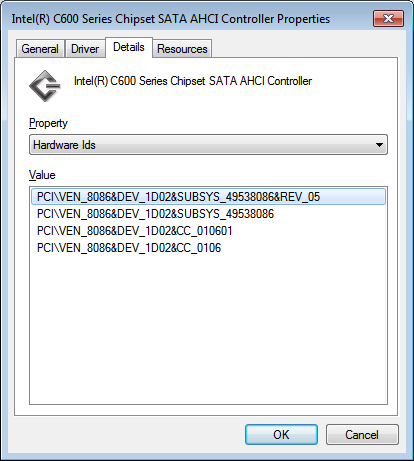
Intel's enterprise chipsets use the Cxxx nomenclature, so this label makes sense. A quick look at Intel's RSTe readme tells us a little more about Intel's C600 controller:
SCU Controllers:
- Intel(R) C600 series chipset SAS RAID (SATA mode)
Controller
- Intel C600 series chipset SAS RAID ControllerSATA RAID Controllers:
- Intel(R) C600 series chipset SATA RAID ControllerSATA AHCI Controllers:
- Intel(R) C600 series chipset SATA AHCI Controller
As was originally rumored, X79 was supposed to support both SATA and SAS. Issues with the implementation of the latter forced Intel to kill SAS support and go with the same 4+2 3Gbps/6Gbps SATA implementation 6-series chipset users get. I would've at least liked to have had more 6Gbps SATA ports. It's quite disappointing to see Intel's flagship chipset lacking feature parity with AMD's year-old 8-series chipsets.
I ran a sanity test on Intel's X79 against some of our H67 data for SATA performance with a Crucial m4 SSD. It looks like 6Gbps SATA performance is identical to the mainstream Sandy Bridge platform:
| 6Gbps SATA Performance - Crucial m4 256GB (FW0009) | ||||||
| 4KB Random Write (8GB LBA, QD32) | 4KB Random Read (100% LBA, QD3) | 128KB Sequential Write | 128KB Sequential Read | |||
| Intel X79 | 231.4 MB/s | 57.6 MB/s | 273.3 MB/s | 381.7 MB/s | ||
| Intel Z68 | 234.0 MB/s | 59.0 MB/s | 269.7 MB/s | 372.1 MB/s | ||
Intel still hasn't delivered an integrated USB 3.0 controller in X79. Motherboard manufacturers will continue to use 3rd party solutions to enable USB 3.0 support.


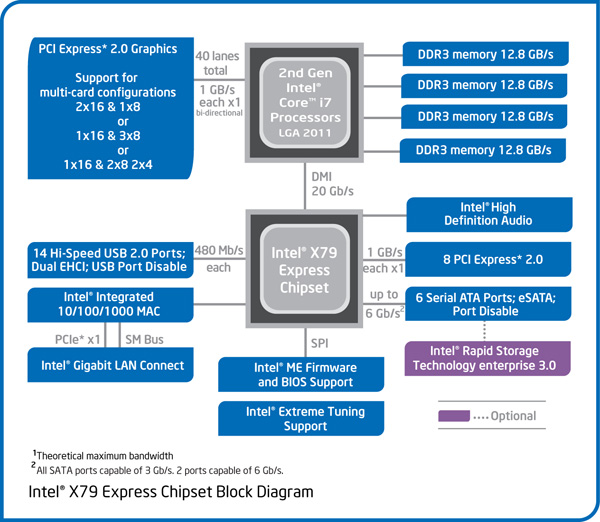
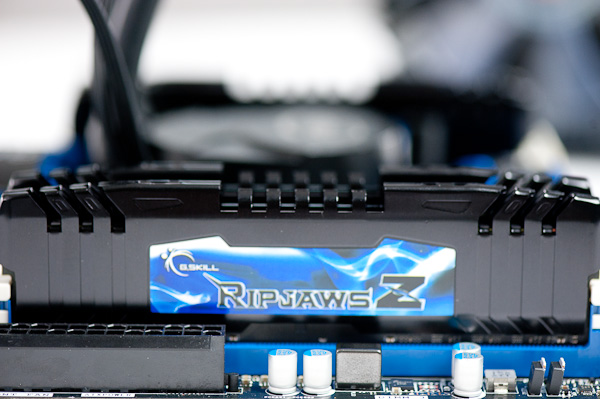
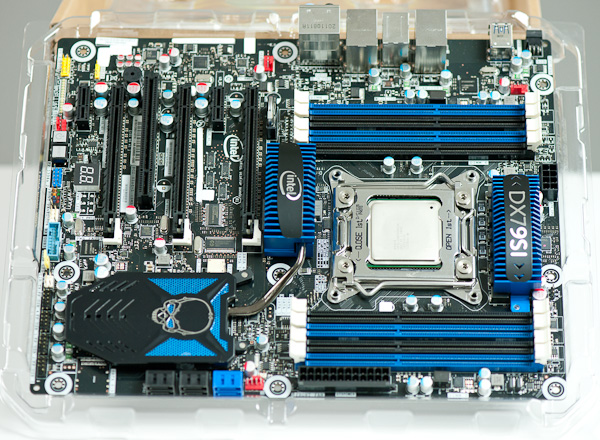
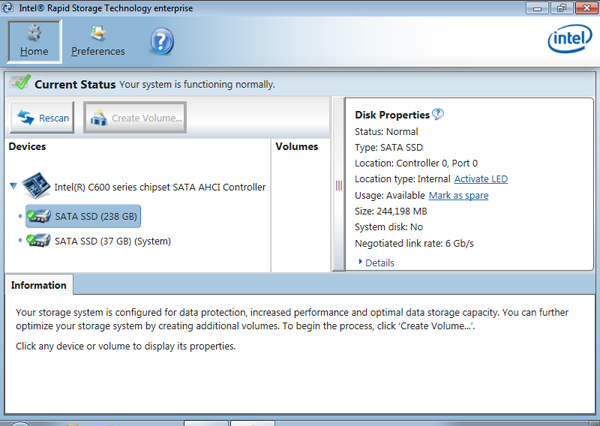








163 Comments
View All Comments
MOBAJOBG - Monday, November 14, 2011 - link
Thanks for performing the analysis and share those information with us.tenks - Monday, November 14, 2011 - link
Am I the only one disappointed with this review?nad, you usually give some amazing insight beyond the simple #s..In this case talking about whats coming up, if this is worth it compared to upcoming stuff in the pipe, or if the rumors about a respin with fixed features, or an allusion to IVy..etc etc etc..?
You've done it in the past. Are you just not allowed to touch on any of this per Intel?
It was a very vanilla review and I dont mean any disrespect, but thats not why I come here for.
Anand Lal Shimpi - Monday, November 14, 2011 - link
I appreciate the criticism. There are a bunch of things I wanted to do that I simply ran out of time for. I added another couple of paragraphs at the end of the conclusion, hopefully directly addressing your concern.To answer you here though: we may see a new chipset offering next year, but IVB-E will probably be at least a year out from now (perhaps even longer). If you need the core count, you will probably be fine on SNB-E while the rest of the world moves to quad-core IVB in the middle of next year.
Take care,
Anand
tenks - Monday, November 14, 2011 - link
Thanks for the response and updating the review..really cool of you. I didn't mean to come off not appreciative, because I am. Just a long time reader who loves the extra insight, reading between the lines and the dot connecting that you do so well...But the more I think about it, maybe it's just the platform itself that I'm disappointed with? Maybe there is no insight really to be had..There is no real "juice" or cool new info we didn't already know about. I guess with all the silence on the platform, even at IDF, I was hoping for that "And one more thing.." feature in SB-E that we didn't know about..Also, forgive me but I have to try..I know you know something..When well the new stepping and 8-core DESKTOP (EE) skus hit?
THizzle7XU - Monday, November 14, 2011 - link
Will there be a video review for this given the time? Your video reviews have been awesome and I really enjoy the conversation type of setting you present. Don't let anyone complain that they are too long :)Also, I was looking forward to this release, but in the last week I've decided to hold off for a while and see what happens with Ivy Bridge. My alternative upgrade ended up being a 512 GB Crucial M4 for my SATA 3 Sandy Bridge laptop and basically had a trickle down effect with moving my Intel 320 SSD to my Core 2 Quad desktop, desktop Intel G2 SSD to PS3, etc. I felt that was a better way to spend $700-$800 at this point for an upgrade that benefited all my devices instead of just my desktop. With the 22 nm process, it there any chance that the mainstream Ivy Bridge will see a 6-core chip? I thought I read some speculation on that...
yankeeDDL - Monday, November 14, 2011 - link
Call me cynical, but reading this review I couldn't help but thinking about AMD Bulldozer's fail.Would we have the 3960X priced $999, if the FX8150 had been able to deliver decent performance (meaning, an 8-core chip beating the i7 2600 by " a little", at $250)?
And the X79 looks just sloppy.
I'm afraid we're starting to see the effect of poor execution by AMD ...
velis - Monday, November 14, 2011 - link
Yep, agree 100%.The chipset released is - as Anand said - a rebrand of existing one. There is absolutely no reason at all to not include SATA 3 and USB 3 all across except if all budget for development was cut.
And the CPU is actually a step back from existing Sandy bridge offerings. No, that was an understatement - it's just a binned existing offering.
Next I'm expecting Ivy delay into late next year at best unless AMD gets its act together.
JlHADJOE - Monday, November 14, 2011 - link
Yes of course it will still be priced at $999.Maybe the 2500k and 2600k will drop in price a bit if Bulldozer had been more competitive, but Intel's Extreme Edition chips have always been pegged at $999.
Lest you forget, it was actually AMD's heydey that drove CPU prices up to the insane levels we are seeing today. Prior to Athlon's dominance, Intel's highest end chip during the Pentium II days, the PII-450 cost around $600.
AMD went on to dominate the chip space after they stuck with their excellent Athlon line, and Intel floundered with the Presshot. Intel was being dominated badly but managed to compete on price. It was AMD who first announced the $1100+ Athlon FX, forcing Intel to re-socket the Gallatin Xeon and sell it as the Pentium 4 Extreme Edition, just undercutting the Athlon FX's price by selling it at $999.
If you look at Intel's track record while they have the performance lead, they have actually been very reasonable with pricing. Recall the $200 Celeron 300A, for instance, which was pretty good at stock, and would overclock into a PII-450 destroyer. Just recently they introduced the brilliant Sandy Bridge, again at about $200-$250, despite the fact that the 2600k destroys their $999 980/990x in gaming.
It was when AMD had the performance lead that the $1000 CPU segment was established,one that has, for better or worse, persisted to this day (despite intel being currently the sole occupant of that segment space).
yankeeDDL - Monday, November 14, 2011 - link
Respectfully, I disagree.First of all, let me be clear: I am not rooting for AMD dominance: I am rooting for "competition" dominance. AMD jacked prices higher when teh Athlon was ridiculizing the P4, and would do so again -I'm sure- if it had the chance.
But it should be recognized that Intel is doing it now. It has "the power" to do so, but that doesn't make it any better for consumers.
Who "started" with the $1000-segment, frankly, is irrelevant: clearly Intel is enjoying it now, so let's focus on that, shall we?
And yes, Intel's top-of the line has always been $999 for a while, however, it is pretty clear that the 3960X is only marginally better than the much more reasonably priced 3930. I don't recall such huge drop in performance/price ratio ever before (I don't have data, but it strikes me as a particularly bad ROI for the 3960).
This said, the X79 is no excuse: re-branding is despicable, no matter who does it.
Also, I think that if the FX8150 was half teh CPU it was supposed to be, instead of the half-ass that it is, Intel would/should have come out with a better improvement over the existing offer, than the 3960 is.
They have delayed SB-E already by a bit, clearly, indicating that not always worked as they planned. If they had to provide an answer to AMD's "compelling" solution, I am sure they would have cranked up SB-E to be a more evident step forward over SB. But given Bulldozer's lack of performance, why bother? They could come out with SB-E "as-is" and not worry about the performance crown, no worry about the ROI, and no worry about cutting features.
just4U - Monday, November 14, 2011 - link
In my opinion, looking at these results Amd's FX8150 isn't so much of a fail after all. Sure it doesn't compare to this beast but they both seem to shine in multi threaded apps and don't seem to be geared up for desktop users. I was expecting to be blown away with the numbers here.... I am not.